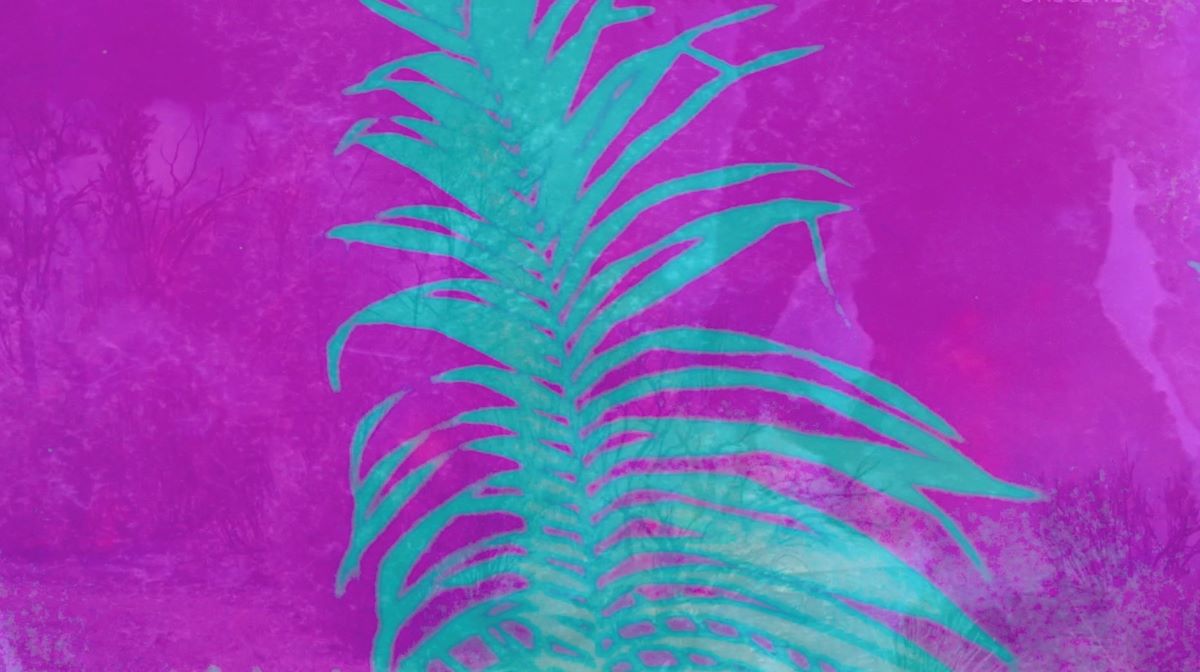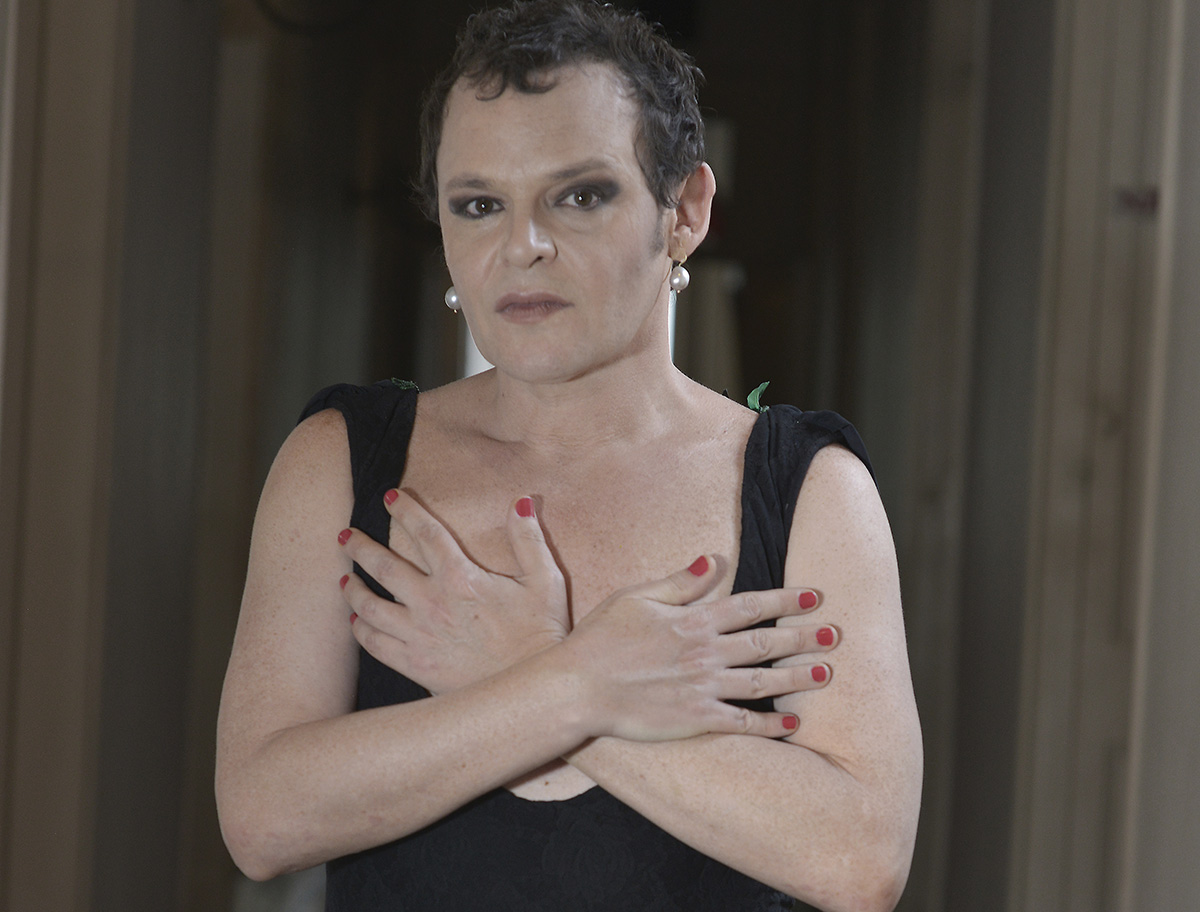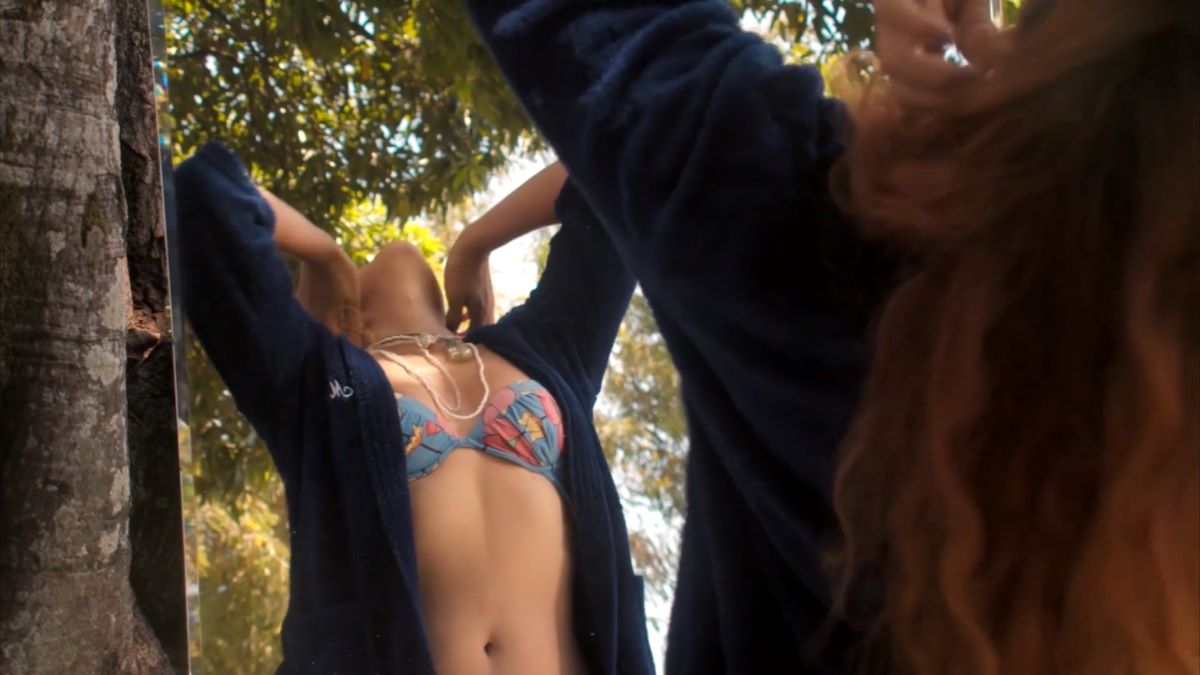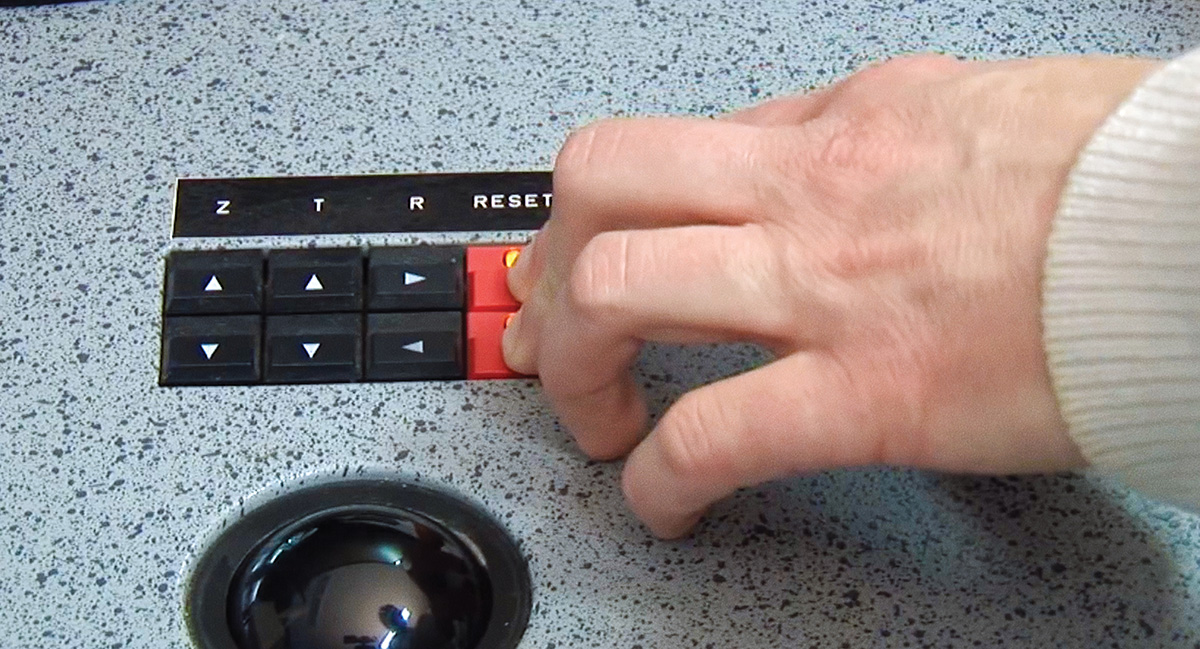Catalogue > Search
Results for : Brésil + Catalogue 2023


Yann Beauvais
evanescent nsw
Film expérimental | 16mm | | 7:35 | France, Brésil | 2023
Document initialement filmé en 16mm dans la nouvelle galles du sud en août 97. Refilmé à la tireuse optique en modifiant la vitesse et l’aspect chromatique, puis laisser décomposer avec le négatif original pendant plusieurs années dans une autre région tropicale. La région a subit de nombreux incendies suite au changement climatique depuis l’époque ou je l’avais brièvement filmée. Le film fait écho à ces transformations dans sa matière même mais aussi avec des found footages et des sons divers.


Diana Blok
Gender Monologues
Installation vidéo | 4k | couleur | 34:49 | Pays-Bas, Brésil | 2016
The installation consists of twelve filmed life-size portraits of actors viewed on six screens, each impersonating their favourite character of the opposite sex, performed in six-minute monologues. In total the installations lasts 72 minutes. The monologues are extracted from, or inspired by lines delivered by iconic characters in drama and literature, both historical and contemporary, criss-crossing time, space and language. During the 72 minute-installation all actors remain visually present, while only one voice speaks at a time. Between silence and the spoken word, the intrinsic tension of male/female border zones is redefined. The result is multidimensional: portraits of our time containing speeches and visions that bring revealing thoughts and insightful conversations about identity, revolution and desire in what feels like a personal confrontation with each actor. We challenge static, mental and cultural conventions by giving back the imagination to the limitations on gender and sexual identity.
Diana Blok is a self-taught visual artist born in Montevideo, Uruguay (1952), she lived in Mexico, Guatemala and Colombia before choosing Amsterdam as a base from which she could function more freely as a female artist. Her nomadic background allows Blok to capture different cultures and identities in her photography and video installations, challenging the structures of the established order as an inspirator, innovator and connector. She investigates subjects as identity, gender, sexual diversity, family structures and culture with poetic and confrontational imagery. In the past 6 years her work evolved into interactive-video installation ’Gender Monologues’, unsettling the gender binary and performing archetypes of femininity and masculinity blurring the disciplines of the moving image, performance and literature. She has had numerous exhibitions worldwide, received the grant for Established Artist from the Mondriaan Foundation in 2020 and will hold a retrospective in the Cobra Museum for Modern and Contemporary Art (NL) in 2024.


Jonathas De Andrade
Olho da Rua
Film expérimental | 4k | couleur | 25:13 | Brésil | 2022
Starring a cast of 100 people, Olho da Rua (Out Loud) is divided into eight acts and presents performance propositions in front of the camera as exercises of the gaze. Simple actions are presented, such as looking and admiring oneself in front of a mirror, improvising an assembly and saying messages to the camera, representing a collective party making the public square a great stage, or facing the camera lens that it's the eye of the beholder, whether on the streets or on the movie screen when it's ready. Made in two days at Praça do Hipódromo, in Recife, the film is made up of a cast of homeless people, linked to public shelters and non-governmental initiatives to support the vulnerable population.
Jonathas de Andrade was born in Maceió, Brazil, in 1982, and studied communications at the Universidade Federal de Pernambuco, Recife. He works with installation, photography, and video to explore constructs of love and the process of urbanization, with particular emphasis on Brazil’s vibrant but often ignored northeast region. De Andrade’s series Love and Happiness in Marriage (Amor e Felicidade no Casamento, 2007) juxtaposes photographic portraits of a young couple with pages from a 1960s psychiatric textbook on love and marriage. What appear to be vintage shots are actually new images of contemporary actors, their treatment and combination framing the popular ideals of romance and family as bourgeois fictions. In 2 in 1 (2 em 1, 2010), diagrams and photographs of carpenters illustrate the process of converting two single beds into a double and also seem to offer functional instruction on how to “make” a couple. Tropical Hangover (Ressaca Tropical, 2009) also employs found material, in this case a salvaged diary that forms the basis for an installation in which a book’s pages are illustrated with original, vintage, and found photographs, offering a reflection on memory, modernity, and urban space. Since 2007, many of de Andrade’s ideas have been developed in collaboration with A Casa como Convém (The House as It Should Be), an artists’ collective that he founded with Cristiano Lenhardt and others in Recife. The group, which focuses on issues around tropical modern architecture, offers a valuable counterpoint to the dominant cultural axis of São Paulo and Rio de Janeiro. One example of the influence of collectivity and local community on de Andrade’s work is The Uprising (O Levante, 2012), for which the artist organized a horse-drawn cart race in the center of Recife. Also inspired by the town is De Andrade’s mural Nostalgia, a Class Sentiment (Nostalgia, Sentimiento de Classe, 2012). This work, constructed from 340 primary-colored geometric fiberglass tiles displayed in a segmented composition, reproduces a tiled panel in a Recife tropical modern house, and is shown opposite a vinyl text that quotes manifestos about modern life composed by two Brazilian architects of the 1960s and ’70s. Some of the tiles interrupt these texts, the suggestion of loss offering pointed comment on the failure of Brazil’s modernist project. De Andrade has had solo exhibitions at Instituto Cultural Itaú, São Paulo (2008); Instituto Cultural Banco Real, Recife (2009); Centro Cultural São Paulo (2010); Kunsthalle Lissabon, Lisbon (2013); and Musée d’art Contemporain de Montréal (2013). He participated in the group exhibitions When Attitudes Became Form Become Attitudes, CCA Wattis Institute for Contemporary Art, San Francisco; and Salvajes: Digesting Europe Piece by Piece, Traneudstillingen Exhibition Space, Copenhagen (both 2012); and EXPO 1: Rio, Museu de Arte Moderna de Rio de Janeiro; Love and Hate to Lygia Clark, Zach?ta National Gallery, Warsaw; HIWAR, Conversations in Amman, Darat al Funun, Amman, Jordan; My Third Land, Frankendael Foundation, Amsterdam; Imagine Brazil, Astrup Fearnley Museet, Oslo; La Bienal 2013: Here is where we jump, El Museo del Barrio, New York; and Moving: Norman Foster on Art, Carré d’Art, Musée d’Art Contemporain, Nîmes (all 2013). He participated in the Mercosul Biennial, Porto Alegre, Brazil (2009); São Paulo Biennial (2010); Sharjah Biennial, United Arab Emirates (2011); Istanbul Biennial (2011); New Museum Triennial: The Ungovernables, New York (2012); and Lyon Biennial (2013). De Andrade lives and works in Recife.


Tamar Guimaraes
Soap: Episode Six and a Half: Talking Soap
Fiction | 0 | couleur | 23:55 | Brésil | 2023
SOAP is a film in seven episodes following the infiltration attempts of a cluster of left-wing people in right-wing social networks. The tactic chosen by the group is the creation of a YouTube channel aimed at teenagers employing the apparently conservative language of religious devotion and self help through prayer. SOAP asks questions such as can a coalition of artists, writers and activists avoid tripping over their own assumptions and privileges to form something persuasive? Is the white left dead? Or rather, have the forms of appeal and address relied upon by the intellectual Lefts ceased to be effective? Is there a way out of the internal bickering and accusations - that continue to hamper political movements? In episode 'six and a half', Camila narrates the previous episodes, reflecting on the project's aims and fractures from the perspective of a post election moment in which the Left was re-elected to the presidency in Brazil.
Tamar Guimarães (b. Belo Horizonte, BR, lives and works in Copenhagen and Berlin) is an artist working with film and installation. Her work has been included at the 33rd, 31st and the 29th São Paulo Biennial; the Belgian Pavilion at the 56th Venice Biennial; the International Exhibition at the 55th Venice Biennial; the LACMA - Los Angeles County Museum of Art (USA); Baltimore Museum of Art (USA); 11th Sharjah Biennial (UAE); the Banff Centre, Alberta (CA); the Guggenheim Museum, NY (USA); the SculptureCenter (NY/USA); the 7th Gwangju Biennial (SK); the 3rd Guanghzhou Triennial (CN); Frac/Le Plateau, Paris (FR); CAC Synagogue de Delme (FR). Her moving image work has been screened at the Les Rencontres Internationales (2014, 2021, 2022); Berlinale Forum Expanded (2019); Blackout, International Film Festival Rotterdam (2019); VIDEONALE, Bonn (2018); Anthology Film Archive, New York (2016); CPH:DOX (2013 and 2007); Images Film Festival and Experimental Media Congress, Toronto, Canada (2010); Architektur-Visionen # 1-6, Metropolis Kino, Hamburg (2015); TRAMWAY art film biennial, Glasgow (2012); Viennale Film Festival, Vienna (2011); and Oberhausen Film Festival (2009). Guimarães’ work is represented in the collections of the Tate Modern (UK); the Solomon Guggenheim Foundation, N.Y. (USA); Museo Nacional Centro de Arte Reina Sofía (ES); Kadist Foundation (SF); Frac Lorraine (FR) among others.


Tamar Guimaraes
SOAP: Episode Six: THEY DON T HAVE JESUS IN THEIR HEARTS
Fiction | digital | couleur | 14:38 | Brésil | 2023
SOAP follows the infiltration attempts of a cluster of left-wing people in right-wing social networks. The tactic chosen by the group is the creation of a YouTube channel aimed at teenagers employing the apparently conservative language of religious devotion and self-help through prayer. In episode six our infiltrators continue to discuss the implications of the soap they are plotting. In the meantime the group has fractured and one of its former member has left the project to pursue traditional politics, preparing to launch her candidacy as a trans councilwoman.
Tamar Guimarães (b. Belo Horizonte, BR, lives and works in Copenhagen and Berlin) is an artist working with film and installation. Her work has been included at the 33rd, 31st and the 29th São Paulo Biennial; the Belgian Pavilion at the 56th Venice Biennial; the International Exhibition at the 55th Venice Biennial; the LACMA - Los Angeles County Museum of Art (USA); Baltimore Museum of Art (USA); 11th Sharjah Biennial (UAE); the Banff Centre, Alberta (CA); the Guggenheim Museum, NY (USA); the SculptureCenter (NY/USA); the 7th Gwangju Biennial (SK); the 3rd Guanghzhou Triennial (CN); Frac/Le Plateau, Paris (FR); CAC Synagogue de Delme (FR). Her moving image work has been screened at the Les Rencontres Internationales (2014, 2021, 2022); Berlinale Forum Expanded (2019); Blackout, International Film Festival Rotterdam (2019); VIDEONALE, Bonn (2018); Anthology Film Archive, New York (2016); CPH:DOX (2013 and 2007); Images Film Festival and Experimental Media Congress, Toronto, Canada (2010); Architektur-Visionen # 1-6, Metropolis Kino, Hamburg (2015); TRAMWAY art film biennial, Glasgow (2012); Viennale Film Festival, Vienna (2011); and Oberhausen Film Festival (2009). Guimarães’ work is represented in the collections of the Tate Modern (UK); the Solomon Guggenheim Foundation, N.Y. (USA); Museo Nacional Centro de Arte Reina Sofía (ES); Kadist Foundation (SF); Frac Lorraine (FR) among others.


Fernando Moletta
Eu, que ignoro tantas coisas, sei que ignoro uma a mais
Vidéo | 4k | couleur | 10:0 | Brésil | 2022
The videoart “I, who ignore so many things, know that I ignore one more" is based on a short story by Brazilian writer Vilma Aguiar. The film aims to ponder between decisions, choices, and mistakes in order to understand the present and project the future through observations about the past, as the misunderstandings resulting from a time full of certainties led us to a hazy and fluctuating period between apathy, anesthesia, post-truth, torment, endless work-fun, euphoria, and fervor. Thus, aware of the yes and no, we could let ourselves be carried away by oscillations, abuse time, and get lost in it, in a lucid labyrinth.
Fernando Moletta is a visual artist and researcher (FBAUL). He holds a Master's degree from the Faculty of Fine Arts of the University of Lisbon. His artistic practice arises from an exploration of the challenges posed by modernism in contemporary times. Through an examination of temporal concepts and their intersections, he delves into the themes of failure, biopolitics, allegorical plasticity, and technological noise. These notions manifest as specters, hovering and intertwining to form a hybrid body of work that encompasses video, sculpture, and drawing. His recent exhibitions include solo shows such as "Three Sad Flawed" at the Gallery of the Faculty of Fine Arts of the University of Lisbon and "O que há entre o acima e o abaixo?" at the Museum of Art of Blumenau (Brazil), as well as group exhibitions including the 14th International Biennial of Contemporary Art in Curitiba (Brazil), "Drifting Time Misplaced" at Mono (Lisbon), "New future" at Industra (Brno, Czech Republic), and the 50th Contemporary Art Salon Luis Sacilotto (Santo André, Brazil). He has also participated in video and cinema festivals such as "Caminhos do Cinema Português" (Coimbra, Portugal) and the 36th Stuttgarter Filmwinter - Festival for Expanded Media (Stuttgart, Germany). He has taken part in artistic residencies at Duplex AiR (Lisbon) and Stalker/Mattatoio (Rome). His work has received awards and is part of the institutional collection at the Museum of Art of Goiânia (Brazil).


Lubanzadyo Mpemba
Sirenes Opacas de São Paulo
Vidéo expérimentale | mov | couleur | 5:42 | Angola, Brésil | 2019
Dans Sirenes Opacas de São Paulo habite la tension entre la ville en tant que béton anonyme qui occupe l'espace, et le monde en tant qu'expérience accumulée dans le corps. Mais la ville est aussi le monde et l'espace est aussi le corps, et chacun porte l'anatomie de souvenirs opaques. L'ampleur des bâtiments face à l'échelle humaine des passants est opaque pour la recherche d'endroits sûrs face à la verticalité imposante. Le geste comme détail du corps qui parle est opaque au bruit de l'abîme urbain. Le suspense inerte qui gratte le ciel est opaque pour les expériences qui se transfigurent à la recherche d'elles-mêmes. Et cette tension ne grandit pas et ne diminue pas, elle est constante et ce qui soutient le mouvement quotidien, et son absence, dans les rues de São Paulo.
Né en Angola en 1989. Artiste transdisciplinaire, Lubanzadyo Mpemba s’exprime dans l’art vidéo, la photo performance, performance et documentaire. Son travail comprend des mises en scène visuelles qui traitent de la migration, de la la gentrification, la violence institutionnelle et la mémoire collective. Il est diplômé en droit et a étudié la sociologie urbaine, Études curatoriales, film et peinture en mouvement.


Ana Vaz
A árvore
Doc. expérimental | 16mm | couleur | 20:32 | Brésil | 2022
Emerging from a regular and spontaneous practice of film, A Árvore is an encounter with and an homage to the filmmaker’s father Guilherme Vaz (1948-2018). Major Brazilian artist, composer, experimental musician and maestro, as well as one of the pioneers of conceptual and sound art in Brazil, his compositions often traverse the filmography of Ana Vaz in a constant dialogue between music, sound and place. Guilherme Vaz’s work is marked by his experience living at the recently inaugurated Brasília, where Ana was born, as well as the many years spent collaborating with remote indigenous communities in the Brazilian Amazon. A Árvore is a ghostly ritual woven through the fragments of a recorded conversation between father and daughter transposed to various significant geographies in life lines of both.
Ana Vaz (1986, Brazil) is an artist and filmmaker who works with cinema as an instrument. Her films, or rather her film-poems, travel through territories and events haunted by the perennial consequences of internal and external forms of colonialism, and their footprints on the earth as well as on human and different from human forms. Her practice can also take the shape of writing, critical pedagogy, installations, film programs or ephemeral events, which are expansions or developments of her films. Her works have been presented at film festivals, seminars and institutions such as Locarno Film Festival – Cineasti del presente; Berlinale Forum Expanded; IFFR, Rotterdam; Viennale; Palais de Tokyo, Paris; Pivô, São Paulo; Jeu de Paume, Paris; CPH:Dox; New York Film Festival – Projections; TIFF Wavelengths, Toronto; BFI, London; Cinéma du Réel, Paris; Tate Modern, London; LUX Moving Images, London; Tabakalera, San Sebastián; Whitechapel Gallery, London; MAM Museum of Modern Art, São Paulo; Matadero, Madrid; Jameel Arts Center, Dubai; Mostra de Cinema de São Paulo; Savvy Contemporary, Berlin; among others. She is a recipient of the Sundance Film Institute Nonfiction Grant (2019), the Film Society of Lincoln Center Kazuko Trust Award (2015), as well as grand prizes at Festival dei Popoli (2022), Entrevues Belfort (2022), FIDOCS (2022), Punto de Vista (2020), 25FPS (2020), Cinéma du Réel (2016), Media City Film Festival (2015), Fronteira Experimental and Documentary Film Festival (2015). Ana Vaz is also a founding member of the COYOTE collective, an interdisciplinary group working between ecology and political science through conceptual and experimental formats.